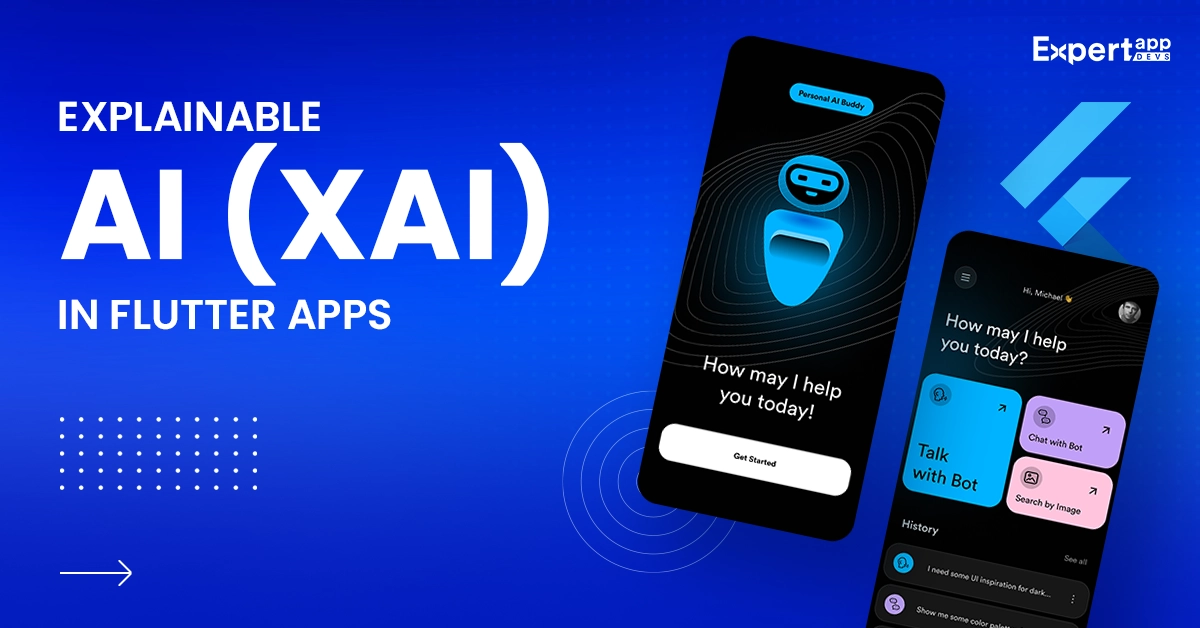The Rise of Explainable AI (XAI) in Flutter Apps: A Competitive Edge for US & UK Businesses
Explainable AI (XAI) is at the forefront of technological innovation, ready to revolutionize businesses across the UK and the US. In the data-driven world, few businesses still lack transparent operating models.
Despite their use of AI, they are unable to showcase how these algorithms are planned. XAI can help overcome this issue by providing in-depth explanations of these algorithms. Similarly, AI algorithms can overcome biases and risks with XAI.
XAI is simplified and intuitive, making it an interesting addition to your business diet. The size of XAI is exponentially increasing. It is expected to reach $24.58 billion by 2030 by statista.
XAI’s potential to increase ethical standards while personalizing the experiences can enhance business outcomes. It can help with fair and transparent processes along with customized paths.
Owing to its incredible benefits, businesses across the UK and the US must embrace it. However, as an established business or startup, you may have several questions regarding XAI. This article will help clear all aspects of XAI while helping you understand the importance of this technology better.
What is Explainable AI?
Artificial Intelligence is integral to most business processes. Several AI models help businesses with their automation and other internal needs. However, these AI models may be wrapped with biases and concerns.
Moreover, it is difficult for the human brain to comprehend these models and interpret them seamlessly. Explainable AI can help understand the biases, explain the AI models and mention how these biases can impact the outcomes.
It translates the models and interprets them for you to ensure complete transparency in the transactions. With explainable systems, the developers are aware of the outcomes, which allows them to ensure the system is working accurately.
Features of XAI
- Interpretability is one of the key features of XAI. It helps you understand how the AI models interpret the data and predict the outcomes. Explainable AI will tell the users on what techniques are used to interpret the model.
- It helps improve the transparency and understanding of the model. The users are taken through techniques like feature importance analysis and model visualization for the correct outcomes.
- XAI fosters transparency. The users can get a complete view of the data that has helped the businesses train and build the AI models. They will also understand the limitations and biases of the model. The users will be made aware of the risks involved while using these models.
- As XAI is used to explain the AI decisions, it furthers the trust among the stakeholders. Once it is clear how the AI models make recommendations or predictions, they are more likely to use the system. It can also make them confident in using the solution.
- The XAI techniques can easily help you identify and mitigate the biases within the AI models. Your users would know whether or not the AI models use unfair or biased means to get the outcomes. The developers can also foster fairness while identifying the factors leading to the desired output.
- XAI makes the collaboration between the AI models and humans easier. The interactions are meaningful using the appropriate feedback loops. Users can also use the technology to explain the decisions defined by the AI systems and guide the model for better outcomes.
- XAI can ensure your AI models adhere to the regulatory requirements borne out of the need to be transparent and accountable. XAI provides clear explanations to justify the AI actions to ensure system adherence.
How Does XAI Flutter Integration Benefit Businesses?
When you integrate XAI with the Flutter application, you will notice several benefits for the business.
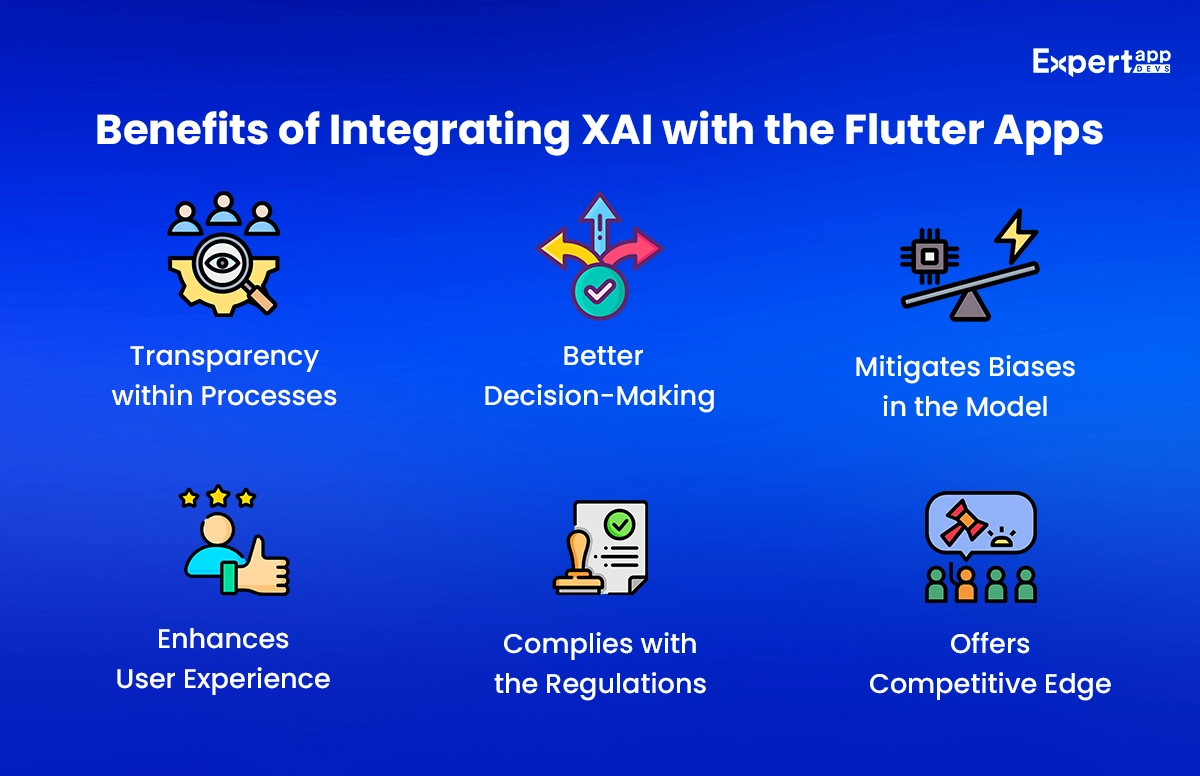
#1. Transparency within Processes
Explainable AI in Flutter app explains the process of decision-making to the end users. This way you are aware of the factors the models take into consideration while developing insights. It would also help build trust among the stakeholders and users. Moreover, the transparency would further loyalty and confidence among the users.
#2. Better Decision-Making
As the businesses using the AI models are aware of the reasoning behind a particular recommendation, they can make more informed decisions. It also helps your stakeholders understand the complex outputs better. This will impact the strategic decision-making abilities of the end user.
#3. Mitigates Biases in the Model
With XAI tools, you can determine the biases within the algorithms. This allows you to treat the users and all opportunities made available to the stakeholders fairly. Businesses that aim to have high ethical standards and wish to comply with industry-standard regulations may benefit from this feature. It will safeguard their reliability and trust while saving them from legal hassles.
#4. Enhances User Experience
When you integrate XAI with Flutter applications, the users are clear about the features and predictions. It helps them use the app in a more defined way. Owing to their ability to comprehend the rationale behind all suggestions, the users engage better. This leads to better experiences and satisfied users.
#5. Complies with the Regulations
Industries across the US and UK need to strictly observe data privacy regulations and ensure fair systems. When they integrate XAI into their Flutter applications, it becomes easier to manage the regulatory requirements. The apps comply better with GDPR, CCPA and other state-specific laws.
#6. Offers Competitive Edge
Businesses can differentiate their systems from others based on factors such as transparency and fairness. XAI integration also enables a user-centric design. This leads to increased trust and satisfaction which guarantees more revenue for the business.
READ MORE: How Flutter App Developers Integrate AI Tech-Stack To Enhance Performance?
Strategies to Implement XAI in the Flutter App
You must follow defined steps to successfully implement XAI in Flutter app development to increase revenue and maximize business opportunities.
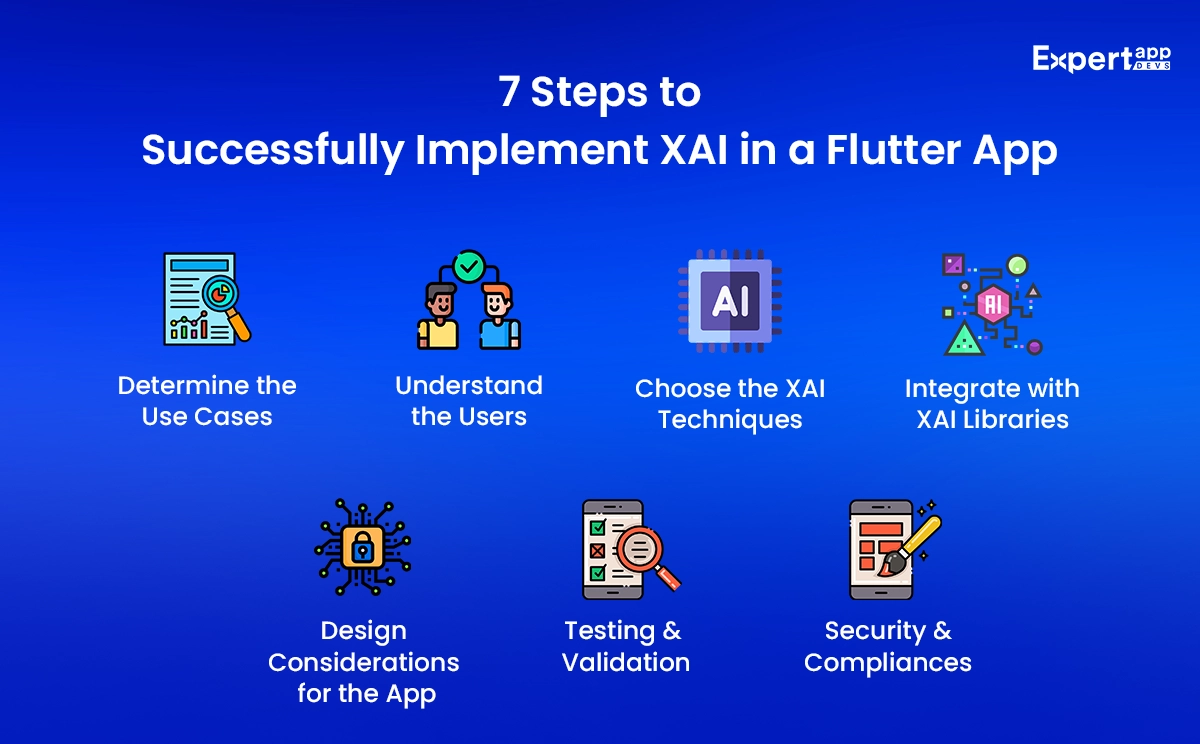
#1. Determine the Use Cases
You must conduct a detailed evaluation of your app’s functionality and assess the interactions. This would help you find the use cases that can add value to your users.
Among the several use cases, find the ones that are likely to impact the user’s experience and decision-making abilities. You must also identify the scenarios where AI-based features or recommendations can add value to the application.
You can connect with the stakeholders and domain experts to find the most valuable connection. Flutter app development services believe understanding the use case is crucial to unfolding the roadmap.
#2. Understand the Users
You must conduct detailed research on the target audience to know their preferences, app expectations and needs. This will help you identify the AI features that will drive more users to the app. You will also understand what kind of explanations the user expects and how to make the app easy to interpret.
#3. Choose the XAI Techniques
There are several XAI techniques, such as feature importance analysis, model interpretation and others. You have already defined the XAI requirements based on use case and user knowledge. This would help you select the technique that best fits the requirement.
Consider the factors like complexity and interpretability while planning your XAI techniques. You must also consider scalability as a factor while planning the XAI technique.
#4. Integrate with XAI Libraries
You must look for XAI libraries that are compatible with Flutter. This would help integrate XAI into your application. These libraries must be in sync with the chosen XAI techniques. You must be able to integrate them into the Flutter development environment as well.
#5. Design Considerations for the App
It is crucial to make your app intuitive and user-friendly. The design should ensure it can send out AI-generated outputs or recommendations seamlessly. You must implement all these factors while creating the design language for the application.
Use visual aids like charts or graphs to make the recommendation easy to understand and interpret. You can also offer contextual explanations for the interactions and decisions made by the user. Your design language must be consistent for a cohesive experience.
Add the explanation UI components into the Flutter app. Make sure to use components like tooltips and dedicated explanation screens to increase user experience. Make sure to design these screens for responsiveness and adaptability.
#6. Testing and Validation
You must conduct detailed testing strategies to make sure the XAI integration with the Flutter app is perfect. Get feedback from real users on usability and functionality. You can also conduct surveys and run analytics to gain validation on the applications.
You must iterate the design based on the feedback and performance metrics to understand if the app is devoid of risks and bugs.
#7. Security and Compliances
Your XAI application must adhere to standard compliances such as data privacy laws. You must incorporate the security best practices to ensure the app is not vulnerable. Moreover, includes solutions that can protect the user’s data and prevent unauthorized access.
It is crucial to monitor the performance of the application and ensure continuous support.
Best Practices for Integration
It is crucial to integrate XAI with your Flutter app using defined practices for the best experiences and outcomes.
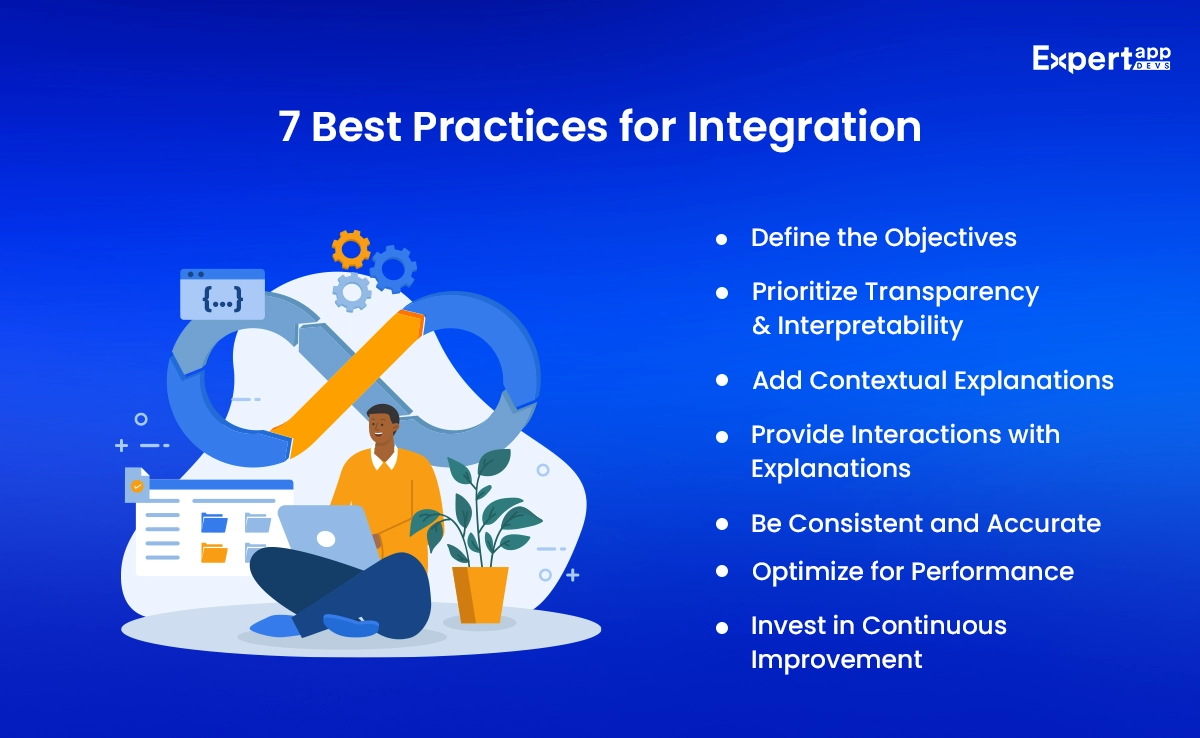
#1. Define the Objectives
Maintaining clarity while defining the objectives is a crucial part of creating an experiential XAI Flutter application. This would help you realize the insights you wish to extend with your app. it can also help you create an app that supports specific decision-making. Hire Flutter app developers to create a strategy based on objectives.
#2. Prioritize Transparency and Interpretability
When you are integrating XAI in Flutter app, you want to ensure easy interpretations and simplicity. The user should be able to understand the rationale behind the algorithm's decision. It should foster trust and reliability on your AI models.
This is why transparency and interpretability should be core to your AI application. You must rely on clear and concise explanations to communicate the AI insights effectively.
#3. Add Contextual Explanations
Whenever the user interacts or reads a recommendation, they should understand the rationale and usefulness. That’s why contextual explanations are important when designing the XAI integration in an application.
You can use displays to offer explanations on particular recommendations. You can even allow users to access specific explanations via prompts or gestures. The idea is to help them understand the interpretation and use it better.
#4. Provide Interactions with Explanations
Some users may want to access the explanation within the application. They may want to read the explanations in detail. You must provide these interactions by allowing input parameter adjustment. You can also allow them to share feedback on the insights offered. This would allow you to improve the explanations to match their needs.
The idea is to offer users complete control on the depth or granularity of the explanations. This would help you iterate and improve the app to meet the user’s preferences and needs.
#5. Be Consistent and Accurate
You must ensure the explanations are consistent with the needs expressed by the AI models. You must also look at the factors that impact the AI-based outputs. When you validate the accuracy and consistency with the relevance, you will get the perfect AI model.
#6. Optimize for Performance
You must optimize the app for performance and responsiveness. Your app must extend a seamless and extensive user experience. You must reduce the latency while creating the AI explanations as that can reduce the engagement and experience.
At the same time, you must optimize the resource utilization for the application. It must be compatible with the device configuration and network conditions.
#7. Invest in Continuous Improvement
You must strive hard to iterate the app continuously. Invest in monitoring the performance, feedback and other aspects. You must regularly refine the designs and incorporate latest XAI techniques that fit your experience and engagement needs.
Challenges of Implementing XAI
Developers and businesses must think through the challenges they are likely to face when you implement XAI in Flutter app. We have identified a few challenges that you can consider during the planning stage.
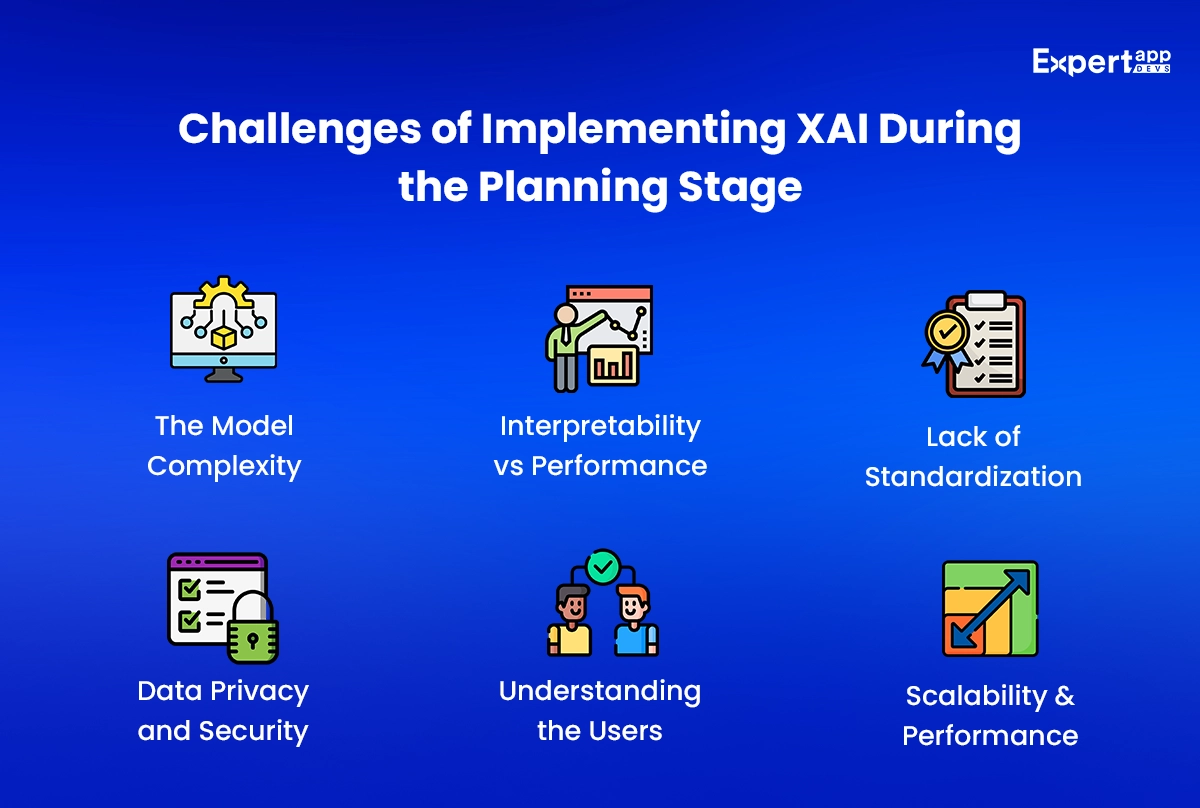
#1. The Model Complexity
The models used in Flutter apps include deep-learning neural networks. It can be complex and opaque. The challenge could be in interpreting the entire model and providing meaningful explanations to the users. You might want to connect with the domain experts before proceeding with the explanations.
#2. Interpretability vs Performance
You may have to trade-off between interpretability and performance. While interpreting the AI models, you might need to simplify them or use less complex algorithms. This can affect the accuracy and efficiency of the algorithm’s performance.
You must ensure while interpreting the application, you don’t let go off the performance of the application.
#3. Lack of Standardization
There are no standards defined for AI output explanation. As a result, each app developer tends to use their variation while designing and implementing the explanation techniques in the application. This makes it difficult for your developers to compare and assess the XAI’s effectiveness.
#4. Data Privacy and Security
When you are integrating XAI with the Flutter application, you may need to provide access to the sensitive data. This is crucial in training the AI models. This can raise privacy and security concerns. You must ensure the data is protected by standard and defined laws.
#5. Understanding the Users
When you want to deliver a successful XAI-Flutter integration, you must curate the explanations that foster trust. However, if the explanations are not in sync with the user’s mental model and expectations, you may experience user resistance.
The best way to support your journey is by collaborating with user experts. They would understand how to derive explanations that fit the user’s requirements.
#6. Scalability and Performance
the biggest challenge lies in scaling the datasets and application to meet your growing datasets. The XAI integration must adapt to the model complexity, increasing users and the need for high engagement. At the same time, XAI should be able to meet real-time requirements as well.
if you don’t plan for growth while keeping performance at the core, you may experience increased attritions.
Ethical Considerations and Risks
You must address the ethical aspects when integrating XAI with your Flutter application.
- AI models may come with inherently biased training data. This can lead to unfair outcomes. You must ensure fair practices while implementing the training data. Make sure to find ways to mitigate the biases through careful data selection and pre-processing.
- XAI integration needs access to sensitive user data. However, this is laden with concerns for data privacy and protection. You can use features like robust data anonymization and encryption measures to protect your user’s privacy and rights.
- Users must have complete control over the interactions made with AI features and explanations. They should be able to customize the recommendations and the explanations. Moreover, you can also offer complete control over the depth and granularity of the explanations.
Conclusion
The integration of Explainable AI with Flutter applications extends numerous opportunities to the businesses in UK and the US. It can help enhance user trust, foster transparency and extend a competitive edge. Moreover, you can offer an incredible experience that helps them engage better with the apps.
The integration will ensure users make informed choices based on their interpretation of the AI model outcomes and the explanations offered. This integration would also remove biases from within the models to improve decision-making.
You must comply with the regulations, incorporate the best practices and outline the ethical considerations for the best outcomes.
You can partner with an AI app development company in the US and UK to attain a competitive edge. Their ethical leadership and expertise in AI models will help you build a relevant and user-centric application.
Connect with Expert App Devs, an expert Flutter app development company, for a smooth process and agile outcomes.
 Jignen Pandya
Jignen Pandya
